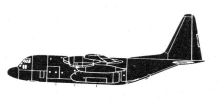Incident Overview

Description
Hercules 130322, radio call-sign BOXTOP 22, was a scheduled resupply flight from Thule Air Base in Greenland to Canadian Forces station (CFS) Alert, an isolated station on the northern tip of Ellesmere Island. The flight departed Thule on 30 October 1991 at 20:05 UTC (16:05 hours local time), carrying five crew members and 13 passengers, and approximately 18,000 litres of arctic diesel fuel in a large cylindrical aluminum tank. The passengers were seated in a small area directly ahead of this bulk fuel delivery system (BFDS). BOXTOP 22 was the second of three aircraft bound for CFS Alert on the afternoon of 30 October. CF6185, a CC-130 not associated with the BOXTOP operation, was approximately 10 minutes ahead of BOXTOP 22 and BOXTOP 21, another CC-130, was approximately 20 minutes behind. The weather was reported as scattered cloud at 9,000 feet, a thin scattered layer at 18,000 feet and ten miles visibility in light snow. The visibility was such that the crew of BOXTOP 22 could observe the rotating beacon of CF6185 on the CFS Alert runway from approximately 25 miles away. The crew was communicating with the radar operator deployed at Alert for the Boxtop operation. The aircraft commander’s original intention was to have the First Officer (FO) fly a Non-Directional Beacon (NDB) approach to runway 29. Believing that there was a potential conflict with the following aircraft, the commander elected, instead, to fly a visual approach to expedite his arrival. The aircraft crashed 10.5 miles southeast of the airport while manoeuvring for the approach. Poor weather, total darkness and rugged terrain were all factors in delaying the arrival of rescue personnel for approximately 32 hours. Four passengers died because of injuries suffered in the crash and the commander succumbed to hypothermia before rescue personnel could arrive on scene. Cause Factors: PERSONNEL PILOT (32A) JUDGEMENT The pilot chose to continue a visual approach after he had lost sight of the airfield complex lighting and when insufficient visual cues existed to confirm safe terrain clearance. PERSONNEL PILOT (32A) TECHNIQUE The pilot failed to maintain the briefed altitude. PERSONNEL CO-PILOT/FIRST OFFICER JUDGEMENT The Co-pilot failed to inform the Pilot that he was not completely satisfied with the decision to descent to 1,500 feet. In addition, although both the Co-pilot and the Flight Engineer were aware that the Pilot had descended at least 100 feet below his briefed level off altitude, they failed to advise him of the error. PERSONNEL NAVIGATOR TECHNIQUE Despite the multiple aids available to him, the Navigator for reasons unknown, misidentified the aircraft position and confirmed an incorrect safety altitude
Primary Cause
Pilot’s decision to continue a visual approach despite potential conflict with other aircraft, compounded by a lack of sufficient situational awareness and inadequate communication regarding the Co-pilot’s dissatisfaction with the descent.Pilot’s decision to continue a visual approach despite potential conflict with other aircraft, compounded by a lack of sufficient situational awareness and inadequate communication regarding the Co-pilot’s dissatisfaction with the descent.Share on:





